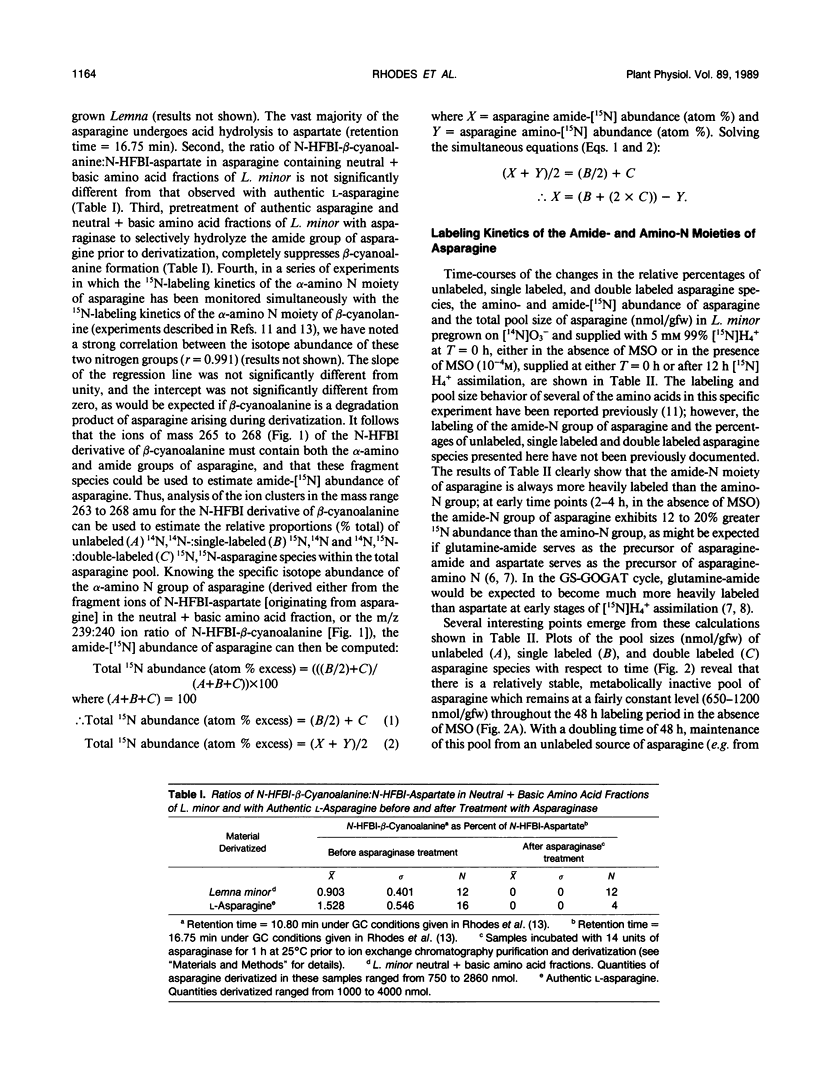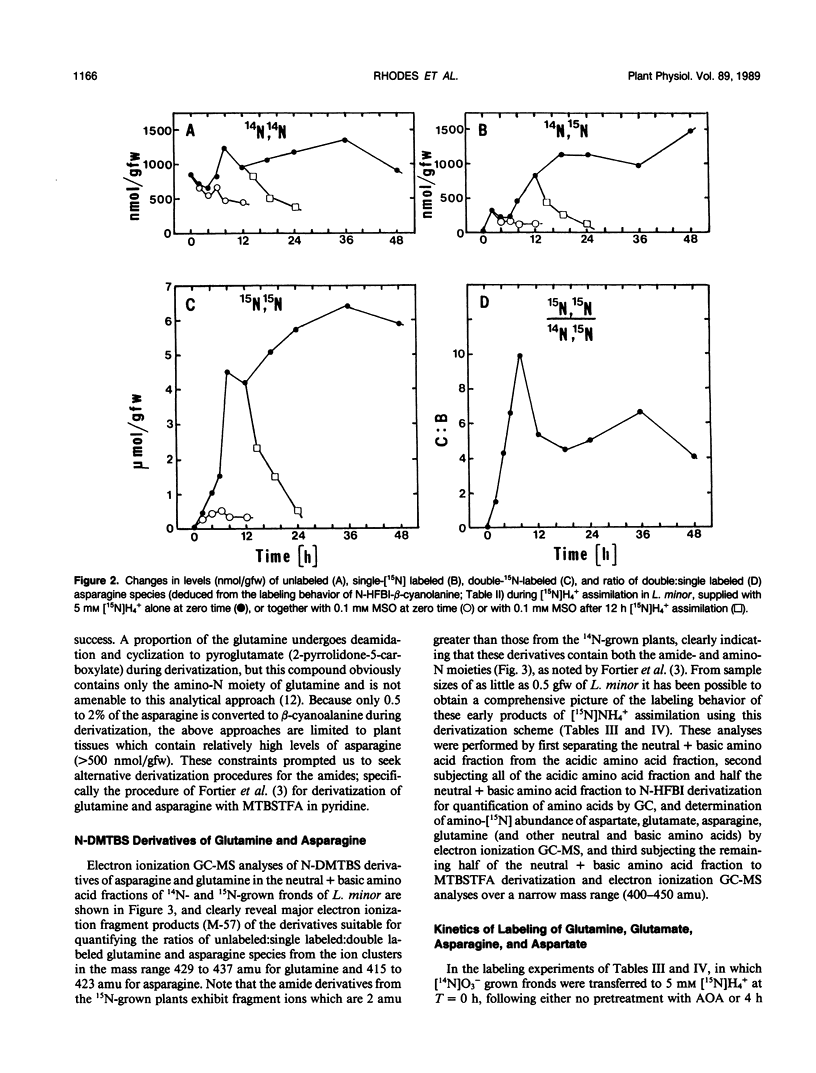Abstract
A serious limitation to the use of N(O,S)-heptafluorobutyryl isobutyl amino acid derivatives in the analysis of 15N-labeling kinetics of amino acids in plant tissues, is that the amides glutamine and asparagine undergo acid hydrolysis to glutamate and aspartate, respectively, during derivatization. This led us to consider an alternative procedure (G Fortier et al. [1986] J Chromatogr 361: 253-261) for derivatization of glutamine and asparagine with N-methyl-N-(tert-butyldimethylsilyl)-trifluoroacetamide in pyridine. Gas chromatography-mass spectrometry (electron ionization) yielded fragment ions (M-57) of mass 417 and 431 for the [14N]asparagine and [14N]glutamine derivatives, respectively, suitable for monitoring unlabeled, single-15N- and double-15N-labeled amide species from the ion clusters at mass to charge ratio (m/z) 415 to 423 for asparagine, and m/z 429 to 437 for glutamine. From separate analyses of the specific isotope abundance of the amino-N groups of asparagine and glutamine as their N-heptafluorobutyryl isobutyl derivatives, the specific amide-[15N] abundance of these amino acids was determined. We demonstrate that this approach to 15N analysis of the amides can yield unique insights as to the compartmentation of asparagine and glutamine in vivo. The ratios of unlabeled:single-15N:double-15N-labeled species are highly diagnostic of the relative sizes and turnover of metabolically active and inactive pools of the amides and their precursors. Kinetic evidence is presented to indicate that a significant proportion (approximately 10%) of the free asparagine pool may be metabolically inactive (vacuolar). If the amide group of asparagine is derived exclusively from glutamine-amide, then asparagine must be synthesized in a compartment of the cell in which both glutamine-amide and aspartate are more heavily labeled with 15N than the bulk pools of these amino acids. This compartment is presumably the chloroplast. The transaminase inhibitor aminooxyacetate is shown to markedly inhibit amino acid synthesis; several amino acid pools accumulated in the presence of aminooxyacetate and [15N]H4+ are 14N-enriched and must be derived primarily from protein turnover.
Full text
PDF










Selected References
These references are in PubMed. This may not be the complete list of references from this article.
- Adams E., Frank L. Metabolism of proline and the hydroxyprolines. Annu Rev Biochem. 1980;49:1005–1061. doi: 10.1146/annurev.bi.49.070180.005041. [DOI] [PubMed] [Google Scholar]
- Brunk D. G., Rhodes D. Amino Acid Metabolism of Lemna minor L. : III. Responses to Aminooxyacetate. Plant Physiol. 1988 Jun;87(2):447–453. doi: 10.1104/pp.87.2.447. [DOI] [PMC free article] [PubMed] [Google Scholar]
- Rhodes D., Deal L., Haworth P., Jamieson G. C., Reuter C. C., Ericson M. C. Amino Acid Metabolism of Lemna minor L. : I. Responses to Methionine Sulfoximine. Plant Physiol. 1986 Dec;82(4):1057–1062. doi: 10.1104/pp.82.4.1057. [DOI] [PMC free article] [PubMed] [Google Scholar]
- Rhodes D., Handa S., Bressan R. A. Metabolic changes associated with adaptation of plant cells to water stress. Plant Physiol. 1986 Dec;82(4):890–903. doi: 10.1104/pp.82.4.890. [DOI] [PMC free article] [PubMed] [Google Scholar]
- Rhodes D., Hogan A. L., Deal L., Jamieson G. C., Haworth P. Amino Acid Metabolism of Lemna minor L. : II. Responses to Chlorsulfuron. Plant Physiol. 1987 Jul;84(3):775–780. doi: 10.1104/pp.84.3.775. [DOI] [PMC free article] [PubMed] [Google Scholar]
- Rhodes D., Myers A. C., Jamieson G. Gas Chromatography-Mass Spectrometry of N- Heptafluorobutyryl Isobutyl Esters of Amino Acids in the Analysis of the Kinetics of [N]H(4) Assimilation in Lemna minor L. Plant Physiol. 1981 Nov;68(5):1197–1205. doi: 10.1104/pp.68.5.1197. [DOI] [PMC free article] [PubMed] [Google Scholar]
- Woo K. C., Flügge U. I., Heldt H. W. A Two-Translocator Model for the Transport of 2-Oxoglutarate and Glutamate in Chloroplasts during Ammonia Assimilation in the Light. Plant Physiol. 1987 Jul;84(3):624–632. doi: 10.1104/pp.84.3.624. [DOI] [PMC free article] [PubMed] [Google Scholar]
- Woo K. C., Morot-Gaudry J. F., Summons R. E., Osmond C. B. Evidence for the Glutamine Synthetase/Glutamate Synthase Pathway during the Photorespiratory Nitrogen Cycle in Spinach Leaves. Plant Physiol. 1982 Nov;70(5):1514–1517. doi: 10.1104/pp.70.5.1514. [DOI] [PMC free article] [PubMed] [Google Scholar]


